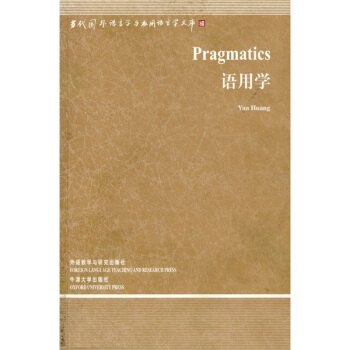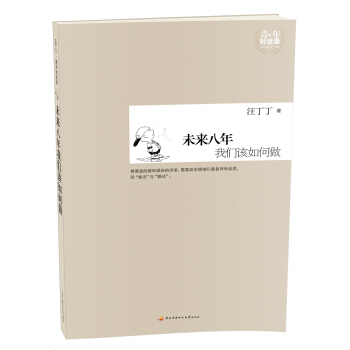

具体描述
内容简介
《语用学》一书作者对语用学与句法学以及语义学的界面进行研究,为我们展现出了一幅比较完整的语用学研究图景。全书『见解独到、内容新颖,是一部优秀的语用学教科书。《语用学》作者黄衍早年留学英国,师从著名语用学家Stephell C.Levinson,获剑桥大学博士学位,后冉获牛津大学博士学位,并曾在这两所人学及雷丁大学执教。黄衍现为新西兰奥克兰久学语言学及应用语言学系教授。目录
PrefaceAcknowledgements
Symbols and abbreviations
1. Introduction
1.1. What is pragmatics?
1.1.1. Adefinition
1.1.2. A brief history of pragmatics
1.1.3. Two main schools of thought in pragmatics: Anglo-American versus European Continental
1.2. Why pragmatics?
1.2.1. Linguistic underdeterminacy
1.2.2. Simplification of semantics and syntax
1.3. Some basic notions in semantics and pragmatics
1.3.1. Sentence, utterance, proposition
1.3.2. Context
1.3.3. Truth value, truth condition, entailment
1.4. Organization of the book
Key concepts
Exercises and essay questions
Further readings
Part Ⅰ Central topics in pragmatics
2. Implicature
2.1. Classical Gricean theory of conversational implicature
2.1.1. The co-operative principle and the maxims of conversation
2.1.2. Relationship between the speaker and the maxims
2.1.3. Conversational implicatureo versus conversational implicature
2.1.4. Generalized versus particularized conversational implicature
2.1.5. Properties of conversational implicature
2.2. Two neo-Gricean pragmatic theories of conversational implicature
2.2.1. The Hornian system
2.2.2. The Levinsonian system
2.3. Conventional implicature
2.3.1. What is conventional implicature?
2.3.2. Properties of conventional implicature
2.4. Summary
Key concepts
Exercises and essay questions
Further readings
3. Presupposition
3.1. What is presupposition?
3.2. Properties of presupposition
3.2.1. Constancy under negation
3.2.2. Defeasibility
3.2.3. The projection problem
3.3. Analyses
3.3.1. The filtering-satisfaction analysis
3.3.2. The cancellation analysis
3.3.3. The accommodation analysis
3.4. Summary
Key concepts
Exercises and essay questions
Further readings
4. Speech acts
4.1. Performativesversus constatives
4.1.1. The performative/constative dichotomy
4.1.2. The performative hypothesis
4.2. Austins felicity conditions on performatives
4.3. Locutionary, illocutionary, and perlocutionary speech acts
4.4. Searles felicity conditions on speech acts
4.5. Searles typology of speech acts
4.6. Indirect speech acts
4.6.1. What is an indirect speech act?
4.6.2. How is an indirect speech act analysed?
4.6.3. Why is an indirect speech act used? Some remarks on politeness
4.7. Speech acts and culture
4.7.1. Cross-cultural variation
4.7.2. Interlanguage variation
4.8. Summary
Key concepts
Exercises and essay questions
Further readings
5. Deixis
5.1. Preliminaries
5.1.1. Deictic versus non-deictic expression
5.1.2. Gestural versus symbolic use of a deictic expression
5.1.3. Deictic centre and deictic projection
5.2. Basic categories of deixis
5.2.1. Person deixis
5.2.2. Time deixis
5.2.3. Space deixis
5.3 Other categories of deixis
5.3.1. Social deixis
5.3.2. Discourse deixis
5.4. Summary
Key concepts
Exercises and essay questions
Further readings
Part Ⅱ Pragmatics and its interfaces
6. Pragmatics and cognition: relevance theory
6.1. Relevance
6.1.1. The cognitive principle of relevance
6.1.2. The communicative principle of relevance
6.2. Explicature, implicature, and conceptual versus procedural meaning
6.2.1. Grice: what is said versus what is implicated
6.2.2. Explicature
6.2.3. Implicature
6.2.4. Conceptual versus procedural meaning
6.3. From Fodorian central process to submodule of theory of mind
6.3.1. Fodorian theory of cognitive modularity
6.3.2. Sperber and Wilsons earlier position: pragmatics as Fodorian central process
6.3.3. Sperber and Wilsons current position: pragmatics as submodule oftheory of mind
6.4. Relevance theory compared with classical/neo-Gricean theory
6.5. Summary
Key concepts
Exercises and essay questions
Further readings
7. Pragmatics and semantics
7.1. Reductionism versus complementarism
7.2. Drawing the semantics-pragmatics distinction
7.2.1. Truth-conditional versus non-truth-conditional meaning
7.2.2. Conventional versus non-conventional meaning
7.2.3. Context independence versus context dependence
7.3. Pragmatic intrusion into what is said and the semantics-pragmatics interface
7.3.1. Grice: what is said versus what is implicated revisited
7.3.2. Relevance theorists: explicature
7.3.3. Recanati: the pragmatically enriched said
7.3.4. Bach: conversational impliciture
7.3.5. Can explicature/the pragmatically enriched said/impliciture be distinguished from implicature?
7.3.6. Levinson: conversational implicature
7.3.7. The five analyses compared
7.4. Summary
Key concepts
Exercises and essay questions
Further readings
8. Pragmatics and syntax
8.1. Chomskys views about language and linguistics
8.2. Chomskys binding theory
8.3. Problems for Chomskys binding theory
8.3.1. Binding condition A
8.3.2. Binding condition B
8.3.3. Complementarity between anaphors and pronominals
8.3.4. Binding condition C
8.4 A revised neo-Gricean pragmatic theory of anaphora
8.4.1. The general pattern of anaphora
8.4.2. A revised neo-Gricean pragmatic apparatus for anaphora
8.4.3. The binding patterns
8.4.4. Beyond the binding patterns
8.4.5. Logophoricity and emphaticness/contrastiveness
8.5. Theoretical implications
8.6. Summary
Key concepts
Exercises and essay questions
Further readings
Glossary
References
Suggested solutions to exercises
Index of names
Index of languages, language families, and language areas
Index of subjects
精彩书摘
1.1.3. Two main schools of thought in pragmatics:Anglo-American versus European ContinentalAs pointed out in Huang (2001a), two main schools of thought can beidentified in contemporary pragmatics: Anglo-American and EuropeanContinental. Within the former conception of linguistics and the philoso-phy of language, pragmatics is defined as the systematic study of meaningby virtue of, or dependent on, language use. The central topics of inquiryinclude implicature, presupposition, speech acts, and deixis (see 1.1 above).This is known as the component view of pragrnatics, namely, the view thatpragmatics should be treated as a core component of a theory of language,on a par with phonetics, phonology, morphology, syntax, and semantics.By contrast, other areas such as anthropological linguistics, applied lin-guistics, and psycholinguistics would lie outside this set of core compon-ents. Within the Continental tradition, pragmatics is defined in a farbroader way, encompassing much that goes under the rubric of sociolin-guistics, psycholinguistics, and discourse analysis. Witness, for example,Verschuerens (1999: 7, 11) definition that pragmatics constitutes a generalfunctional (i.e. cognitive, social and cultural) perspective on linguisticphenomena in relation to their usage in the form of behaviour. Thisrepresents the perspective view of pragmatics, namely, the view that prag-matics should be taken as presenting a functional perspective on everyaspect of linguistic behaviour. More or less the same is true of the definitionof pragmatics provided within the former Soviet and East European trad-ition. Under this approach, pragmatics (called pragmalinguistics) is ingeneral conceived of as a theory of linguistic communication, includinghow to influence people through verbal messages (Prucha 1983).
前言/序言
The aim of this book is to provide an authoritative, up-to-date, and yetaccessible introduction to contemporary linguistic pragrnatics.In contemporary pragmatics, two main schools of thought can be iden-tified: Anglo-American and European Continental. Within the formerconception of linguistics and the philosophy of language, pragrnatics isdefined as the systematic study of meaning by virtue of, or dependent on,language use. The central topics of inquiry include implicature, presuppos-ition, speech acts, and deixis. This is known as the component view ofpragmatics, namely, the view that pragmatics should be treated as a corecomponent of a theory of language, on a par with phonetics, phonology,morphology, syntax, and semantics. By contrast, other areas such asanthropological linguistics, applied linguistics, and psycholinguisticswould lie outside this set of core components. Within the Continentaltradition, pragmatics is defined in a far broader way, encompassing muchthat goes under the rubric of, say, sociolinguistics, psycholinguistics, anddiscourse analysis. The Continental approach represents the perspectiveview of pragmatics, namely, the view that pragmatics should be taken aspresenting a functional perspective on every aspect of linguistic behaviour.Given the degree of overlap among the phenomena dealt with in otherrelatively well-established interdisciplinary fields of linguistics such associolinguistics, psycholinguistics and neurolinguistics, it is rather difficultto see how a coherent research agenda for pragmaties can be made withinthe wider Continental tradition. By contrast, the narrower Anglo-American, component view of pragmatics, which focuses on topics emer-ging from the traditional concerns of analytical philosophy, delimits thescope of the discipline in a relatively coherent, systematic, and principledway. In this book, therefore, my discussion of pragmatics will largely befrom the Anglo-American, component point of view.
用户评价
对于那些寻求实用工具书的读者来说,这本书可能需要稍微调整一下心态。它更像是一份深刻的“思维导图”,而非一套即插即用的沟通技巧手册。我发现,它在论证过程中,大量引用了认知心理学的研究成果,试图从大脑处理信息、形成偏见的过程来解释为什么人们在特定情境下会选择特定的表达方式。比如,关于“框架效应”如何被精心设计的公共宣传所利用,书中给出了非常精彩的案例剖析,揭示了语言结构如何潜移默化地引导公众的判断。这部分内容读起来需要全神贯注,因为它要求读者不仅仅是接受信息,更要主动去解构信息。我个人的建议是,最好能备着一支笔,在关键的论点旁做标记,因为很多观点是需要反复咀嚼才能真正消化的。它不是一本可以轻松放在床边消遣的书,更像是一次智力上的小挑战。
评分坦白说,我最初是被朋友强烈推荐才翻开这本书的,当时心里还有点忐忑,怕又是那种晦涩难懂的学术著作,读几页就得查阅大量的背景资料。然而,这本书的叙事方式完全颠覆了我的预期。它采用了大量的对比手法,将不同文化背景下的日常对话情景并置,比如在东方集体主义文化中,一个“不确定”的回答背后隐藏的复杂考量,与西方直接表达偏好的习惯之间的张力,描绘得淋漓尽致。阅读过程中,我常常会停下来,回想自己最近与同事、家人交流时的细微之处,瞬间感觉自己对那些“说了一半的话”有了更深层次的理解。书中的一些章节,像是对“潜台词”的系统性解读,用一种近乎侦探小说般的严谨态度,去解构那些我们习以为常却从未深思的交流模式。这种对日常现象的提炼和升华,让这本书的阅读体验非常独特,仿佛打开了一扇观察人类行为模式的“侧门”。
评分这本书的封面设计简洁大气,那种深沉的蓝色调,配上烫金的书名,第一眼就给人一种内容厚重、值得细品的印象。我拿到手的时候,特地感受了一下纸张的质感,厚实且细腻,翻起来手感极佳,可见出版方在制作上是下了功夫的。内容上,我主要关注的是它对现代社会中“话语权”变迁的探讨。作者似乎并没有过多地纠缠于传统的语言学分支,而是将焦点放在了信息爆炸时代,社交媒体和新型传播媒介如何重塑人们的交流习惯和认知框架上。特别是关于“沉默的螺旋”在网络语境下的新表现形式,这本书提供了非常新鲜且有力的案例分析,让我这个长期关注舆论场动态的人大有启发。它不是一本枯燥的理论手册,更像是一部结合了社会学洞察的观察手记,文字流畅,逻辑严密,即使是初次接触相关领域的人,也能被它层层递进的论证所吸引。我特别欣赏作者在举例时那种恰到好处的分寸感,既有深度又不失鲜活。
评分这本书的排版和注释系统做得相当出色,这对于一本涉及多领域引用的著作来说至关重要。我注意到,作者在引用西方经典理论时,对翻译的术语进行了解释,同时在涉及亚洲特定社会现象时,也保持了足够的敏感度,避免了简单粗暴的文化套用。这使得全书的论述基调非常平衡、客观。从装帧设计到内文的布局,都透露出一种对知识的敬畏感。虽然全书篇幅不薄,但阅读起来并不觉得拖沓,因为每章的过渡都衔接得非常自然,仿佛是顺着一条河流在探寻源头。总的来说,这是一部值得在书架上占据一席之地,并且会让人愿意时常翻阅,每次都能发现新亮点的作品。它没有提供简单的答案,但它教会了我如何提出更深刻的问题。
评分这本书最令我感到惊喜的是其跨学科的视野。它成功地将传统的人类学观察与当代的技术哲学思辨结合了起来。其中有一章专门探讨了人工智能模型在生成文本时所体现出的“学习性偏误”,这绝对是全书的点睛之笔。作者并没有将AI视为一个简单的工具,而是将其视为一个放大了的人类交流缺陷的镜子。通过分析AI在特定语料库上表现出的刻板印象重现,我们反过来可以更清晰地审视我们自己语言习惯中的盲区和不公。这种由表及里,再由技术反观人性的探讨路径,非常具有前瞻性。阅读完毕后,我感觉自己对未来的人机交互模式有了一种全新的预判,不再是盲目乐观,而是带着一种审慎的、充满批判性的眼光去看待每一次算法的迭代。
评分专业性还是挺强的,推荐看看相关的中文再看这本英文的
评分送货挺快的,拿到书质量也不错。。
评分很专业的一本书,值得阅读,此人大师也,推荐指数五颗星
评分跟你交易次次都这么成功和开心的..
评分语用学经典之作,有些章节甚至段落与黄先生老师的著作非常相似。
评分书是中国人编的,涉及的范围挺广的,语言也易懂,挺好的,但有些方面还是有些简略,需要自己再找别的材料来看。京东还是不错的,赞个
评分书是中国人编的,涉及的范围挺广的,语言也易懂,挺好的,但有些方面还是有些简略,需要自己再找别的材料来看。京东还是不错的,赞个
评分正品,以后需要继续购买,物流稍慢
评分"[SM]和描述的一样,好评! 上周周六,闲来无事,上午上了一个上午网,想起好久没买书了,似乎我买书有点上瘾,一段时间不逛书店就周身不爽,难道男人逛书店就象女人逛商场似的上瘾?于是下楼吃了碗面,这段时间非常冷,还下这雨,到书店主要目的是买一大堆书,上次专程去买却被告知缺货,这次应该可以买到了吧。可是到一楼的查询处问,小姐却说昨天刚到的一批又卖完了!晕!为什么不多进点货,于是上京东挑选书。好了,废话不说。好了,我现在来说说这本书的观感吧,一个人重要的是找到自己的腔调,不论说话还是写字。腔调一旦确立,就好比打架有了块趁手的板砖,怎么使怎么顺手,怎么拍怎么有劲,顺带着身体姿态也挥洒自如,打架简直成了舞蹈,兼有了美感和韵味。要论到写字,腔调甚至先于主题,它是一个人特有的形式,或者工具;不这么说,不这么写,就会别扭;工欲善其事,必先利其器,腔调有时候就是“器”,有时候又是“事”,对一篇文章或者一本书来说,器就是事,事就是器。这本书,的确是用他特有的腔调表达了对“腔调”本身的赞美。|发货真是出乎意料的快,昨天下午订的货,第二天一早就收到了,赞一个,书质量很好,正版。独立包装,每一本有购物清单,让人放心。帮人家买的书,周五买的书,周天就收到了,快递很好也很快,包装很完整,跟同学一起买的两本,我们都很喜欢,谢谢!了解京东:2013年3月30日晚间,京东商城正式将原域名360buy更换为jd,并同步推出名为“joy”的吉祥物形象,其首页也进行了一定程度改版。此外,用户在输入jingdong域名后,网页也自动跳转至jd。对于更换域名,京东方面表示,相对于原域名360buy,新切换的域名jd更符合中国用户语言习惯,简洁明了,使全球消费者都可以方便快捷地访问京东。同时,作为“京东”二字的拼音首字母拼写,jd也更易于和京东品牌产生联想,有利于京东品牌形象的传播和提升。京东在进步,京东越做越大。||||好了,现在给大家介绍两本本好书:《谢谢你离开我》是张小娴在《想念》后时隔两年推出的新散文集。从拿到文稿到把它送到读者面前,几个月的时间,欣喜与不舍交杂。这是张小娴最美的散文。美在每个充满灵性的文字,美在细细道来的倾诉话语。美在作者书写时真实饱满的情绪,更美在打动人心的厚重情感。从装祯到设计前所未有的突破,每个精致跳动的文字,不再只是黑白配,而是有了鲜艳的色彩,首次全彩印刷,法国著名唯美派插画大师,亲绘插图。|两年的等待加最美的文字,就是你面前这本最值得期待的新作。《洗脑术:怎样有逻辑地说服他人》全球最高端隐秘的心理学课程,彻底改变你思维逻辑的头脑风暴。白宫智囊团、美国FBI、全球十大上市公司总裁都在秘密学习!当今世界最高明的思想控制与精神绑架,政治、宗教、信仰给我们的终极启示。全球最高端隐秘的心理学课程,一次彻底改变你思维逻辑的头脑风暴。从国家、宗教信仰的层面透析“思维的真相”。白宫智囊团、美国FBI、全球十大上市公司总裁都在秘密学习!《洗脑术:怎样有逻辑地说服他人》涉及心理学、社会学、神经生物学、医学、犯罪学、传播学适用于:读心、攻心、高端谈判、公关危机、企业管理、情感对话……洗脑是所有公司不愿意承认,却是真实存在的公司潜规则。它不仅普遍存在,而且无孔不入。阅读本书,你将获悉:怎样快速说服别人,让人无条件相信你?如何给人完美的第一印象,培养无法抗拒的个人魅力?如何走进他人的大脑,控制他们的思想?怎样引导他人的情绪,并将你的意志灌输给他们?如何构建一种信仰,为别人造梦?[SZ]"
相关图书
本站所有内容均为互联网搜索引擎提供的公开搜索信息,本站不存储任何数据与内容,任何内容与数据均与本站无关,如有需要请联系相关搜索引擎包括但不限于百度,google,bing,sogou 等,本站所有链接都为正版商品购买链接。
© 2025 windowsfront.com All Rights Reserved. 静流书站 版权所有












![第二语言研究中的问卷调查方法(第2版) [Questionnaires in Second Language Research:Construction,Administration,and Processing(Second Edition)] pdf epub mobi 电子书 下载](https://pic.windowsfront.com/10888254/6bbc956b-ee01-4a5a-a6d7-34e2f51095d6.jpg)

![当代国外语言学与应用语言文库(第3辑)·认知语义学(卷1):概念结构系统 [Toward a Cognitive Semantics(Volume 1):Concept Structuring Systems] pdf epub mobi 电子书 下载](https://pic.windowsfront.com/10963817/e49246bf-9fbf-42c8-821e-45eec1481287.jpg)





